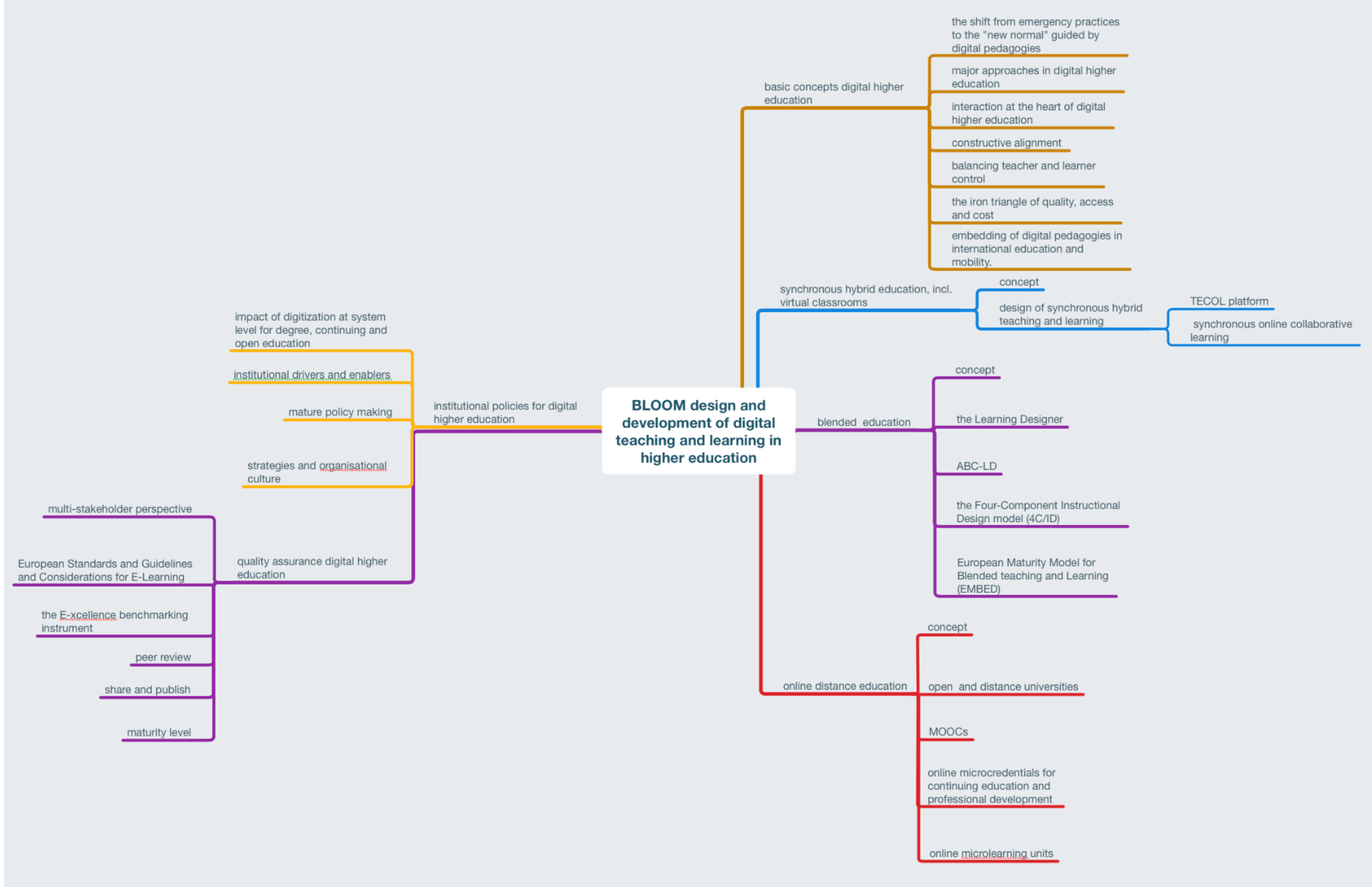Piet Henderikx, George Ubachs, Alessandra Antonaci
These guidelines were carried out at EADTU European Association of Distance Teaching Universities
This work was funded through the KA3 Erasmus+ Programme, project NR.: 606692-EPP-1-2018-2-FR-EPP- KA3-PI-POLICY, coordinated by Université Paris 1 Panthéon-Sorbonne.
It will be published on the European BLOOM Hub for Digital Teaching and Learning, Networking and Mobility. The BLOOM hub is part of the OpenU project.



This document has been prepared for the European Commission. However, it represents only the opinion of the authors and the Commission cannot be held responsible for any use that may be made of the information contained therein.

Authors
Piet Henderikx, George Ubachs, Alessandra Antonacci
Final editing
Beau Nijsten
Beau Nijsten
Publisher
Global Academic Press
ISBN:
NUR:
eBook design
Marian Sloot || www.proefschriftmaken.nl
Citation
Henderikx, P., Ubachs, G., & Antonaci, A. (2022). Models and guidelines for the design and development of teaching and learning in digital higher education. Global Academic Press. DOI: …………..
Imagemap
Tags: teaching and learning design, synchronous hybrid education, blended education, online
distance education, quality assurance digital higher education, institutional policy strategies and
frameworks digital higher education; COVID emergency practices in higher education; the European
Maturity Model for blended education (EMBED); the E-xcellence quality benchmarking instrument
for digital higher education; the TECOL platform; hybrid virtual classrooms; synchronous online
collaborative learning; the Learning Designer; ABC Learning Design (ABC-LD); Four-Component
Instructional Design (4CID); open and distance teaching universities; MOOCs; digital microcredentials;
microlearning units.
Acknowledgements to the experts of the following EU funded projects:
- European Maturity Model for Blended Education (EMBED)
- Professional Development for Digital Teaching and Learning (DigiTel Pro)
Content

The iron triangle of quality, access and cost
List of figures
Fig. 1. BLOOM models and guidelines for the design and development of digital teaching and
learning in higher education
Fig. 2. Basic concepts in digital higher education
Fig. 3. Interaction as the core of teaching and learning
Fig. 4. The “iron triangle” showing that technology can stretch the vectors of quality and access at a
lower cost (Daniel, J., 2016)
Fig. 5. Concept and design of synchronous higher education
Fig. 6. A virtual classroom setting
Fig. 7. Activity-centered analysis and design framework (Goodyear, Carvalho and Yeoman, 2021)
Fig. 8. Blended education: concept and design models
Fig. 9. The blended learning wave (van Valkenburg et al., 2020)
Fig. 10. Examples of online and offline educational formats. (van Valkenburg et al., 2020)
Fig. 11. Designer screen for creating a learning design from scratch (the Learning Designer)
Fig. 12. Directory screen for a session on collaborative learning
Fig. 13. A sequence of learning cards per week indicating the learning type. At the reverse side of the
cards examples of learning activities are given (ABC-LD toolkit).
Fig. 14. Examples of learning activities for each learning type: V-visible learning; A- can be assessed
(ABC-LD toolkit)
Fig. 15. A storyboard with learning activities and an analytic graph.
Fig. 16. Learning types and technological tools (ABC-LD, UCL Digital Education)
Fig. 17. A graphical view on the four components: (a) learning tasks, (b) supportive information, (c)
procedural information, and (d) part-task practice (Jeroen J. G. van Merriënboer, 2020)
Fig. 18. Spider charts after multi-layer maturity decision-making assessment
Fig. 19. EMBED maturity dimensions at the course level
Fig. 20. EMBED maturity dimensions at the programme level
Fig. 21. EMBED maturity dimensions of institutional policies and conditions:
Fig. 22. Online distance education: concept and design in context
Fig. 23. Virtual learning space with learning activities at the centre, and interactions with learning
resources, teaching staff and a networked community
Fig. 24 Mandatory and optional elements in the Recommendation of the EU Council of Ministers on
Micro-credentials
Fig. 25. Quality assurance in digital higher education
Fig. 26. E-xcellence, toward an E-xcellence Associate Label
Fig. 27. Institutional policies for digital higher education
Fig. 28. Impact of digitalization of higher education at system level in the three areas of provision:
degree education, continuing education and professional development and open education
Fig. 29. The drivers of professional activity in the HE system balanced against the enablers for
innovation in learning technology (bold indicates the more powerful ones) (Laurillard, 2012, 2015)
next chapter: Introduction